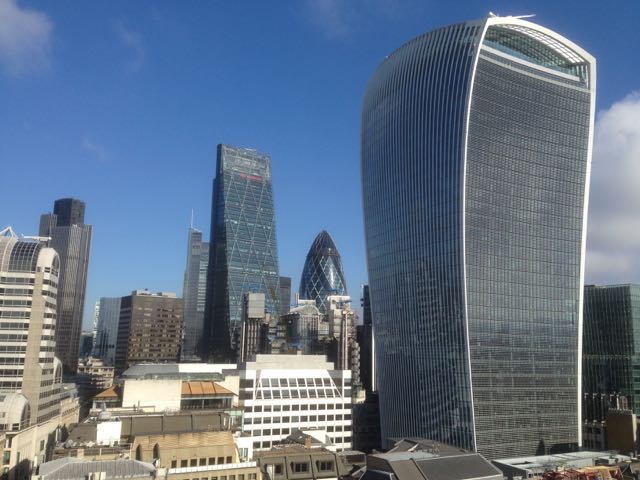Post
REPORT | The History and Future of Tall Buildings
2 Oct 2017
As part of the Society’s London Icons series, Emily Gee, Historic England’s London Planning Director, looked at the historic context of building tall in London – Finbar Bradley reports:
In recent times the structures that most people would perceive as iconic have tended to be London’s new breed of tall buildings. On Thursday night and firmly with our feet on the ground at Cowcross Street, the London Society heard a dynamic “short history of London” from the 1600’s until the present. Emily Gee of Historic England took people on a journey from the disasters which brought about planning reform, through the backlash of early attempts to create tall buildings and to future possibilities.
The height of a building is determined by a number of factors – possibly a specific use, perhaps the limitations of construction techniques, maybe firefighting requirements and the necessity to be safe, or perhaps the value of land and a necessity for fiscal return. More often than not however, a tall building becomes tall as a reflection of power and stature.
Though slender church steeples filled the London sky line for the majority of its existence, one building stood above all others: St. Paul’s Cathedral – in both its medieval and Wren incarnations - its stature acting as a symbol of pride and strength. It was not until the 19th Century before competition began to form on the opposite side of the river through industrial growth at Southbank.
After the 1666 Great Fire of London the first building regulations were created which aimed to limit the height people could build as well as the materials that could be used in construction. This was a way of ensuring buildings could be protected in the event of a fire and that the then low-tech fire fighting abilities would not become overwhelmed. Anything that would be taller than this would be looked at on a case-by-case basis.
Two different means of approaching tall buildings existed at the middle of the 1800s. New York and Chicago were building increasingly taller structures due to the use of steel, however London and Paris still remained very low rise cities. This was not due to a lack of the technology in the capital but was instead down to a 1774 building act.
In 1800, few buildings raised their parapets above 4-5 stories and the skyline of London was still dominated with the steeples and towers of churches. Brick buildings had the ability to be built as high as 10 stories however the added discomfort of this was not felt to be desirable in London and very few buildings increased in scale. Some buildings were allowed to be built taller such as Henry Hanky’s 151’ (45m) Queen Anne Mansion (1893) which used lifts to overcome the discomfort of travelling to these greater heights however these buildings tended to be loathed by the public due to their lofty nature. This led to an 1894 Act which imposed a 100’ height limit on London buildings.
The construction of the Unilever Building led to public uproar due to its scale against St. Paul's cathedral. W. Godfrey Allen in turn created a series of photo montaged images indicating important historical sight lines for the cathedral which needed to be protected so that development did not consume the city. This resulted in one of the longest standing ‘gentlemen’s agreements’, which was later agreed in 1989 with the City Corporation, that on six specific sight lines, a building shall not raise above the railings of St. Paul’s. A further two sight lines exist toward Westminster Abbey.
In 1954 height restrictions were replaced with a height/width ratio of 5:1 by site which led to slenderer buildings and gave way to space at the foot of each building. This did not reduce the height of buildings however, which led to the 2001 investigation by London Planning Advisory Committee as to the necessity for tall buildings which “was not convinced that tall buildings are essential for the future of London as a global financial centre” However, Ken Livingstone, the then mayor encouraged the building of numerous tall towers.
In more recent times, buildings such as the Shard and the Leadenhall Building have given great respect for the city and created icons which have spearheaded growth. Historic England have argued against 16 proposals with only 6 of these being granted. The intention now is that the buildings must inform and enhance the character of the area. Emily highlighted that Historic England agree that tall buildings can contribute to the city but do have a wider impact than most typical construction. Heritage is still at risk and therefore eternal vigilance is required.
It was reassuring and welcoming to see people in the audience held a very strong view about the recent development of tall buildings whilst also understanding the inherent necessity for this scale of development. One member commented that we stood in a unique position between Paris and New York and we needed to maintain this juxtaposition of scale and tread carefully with the past.
The success of London has come from the play of scale and the cities ability to replace and develop ubiquitously rather than in isolated nodes. It is important therefore that this tradition continues however it is also of upmost importance that this is also informed by the buildings that preface these.
